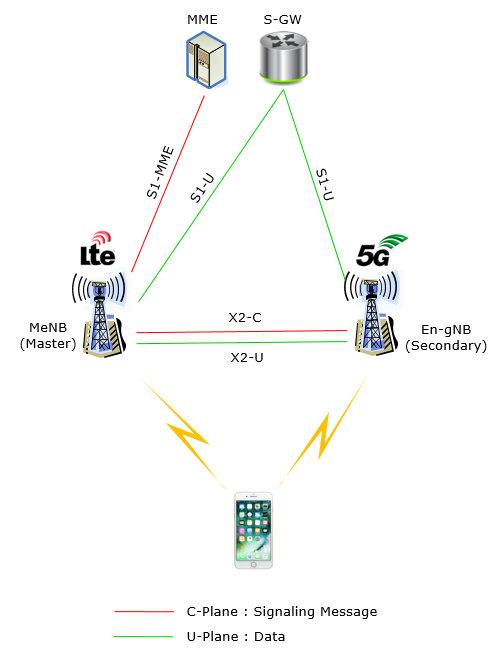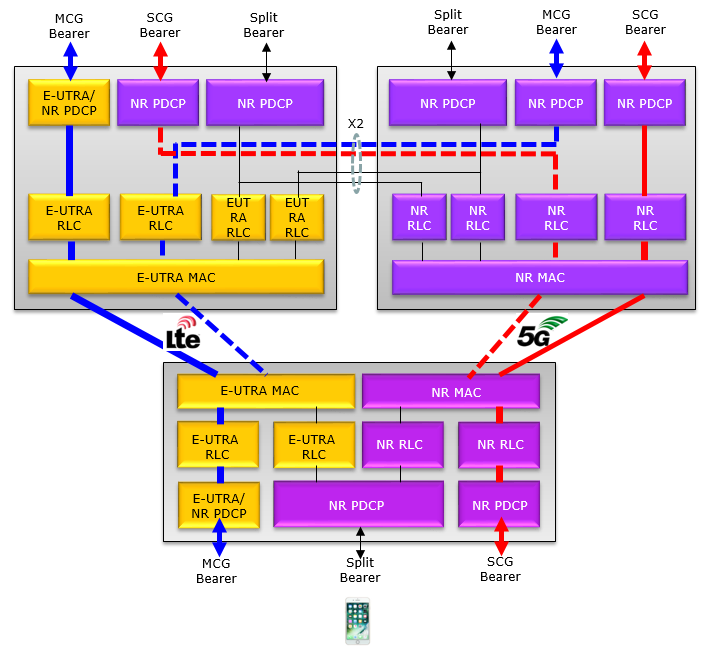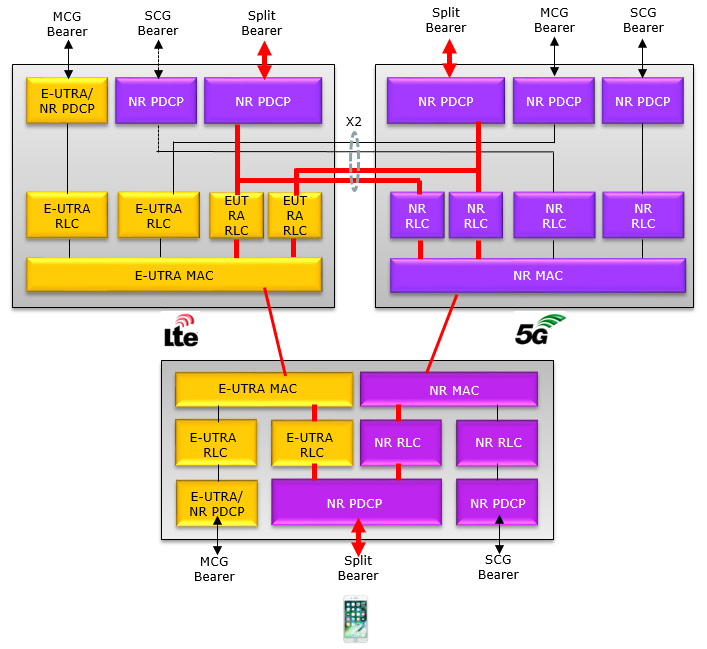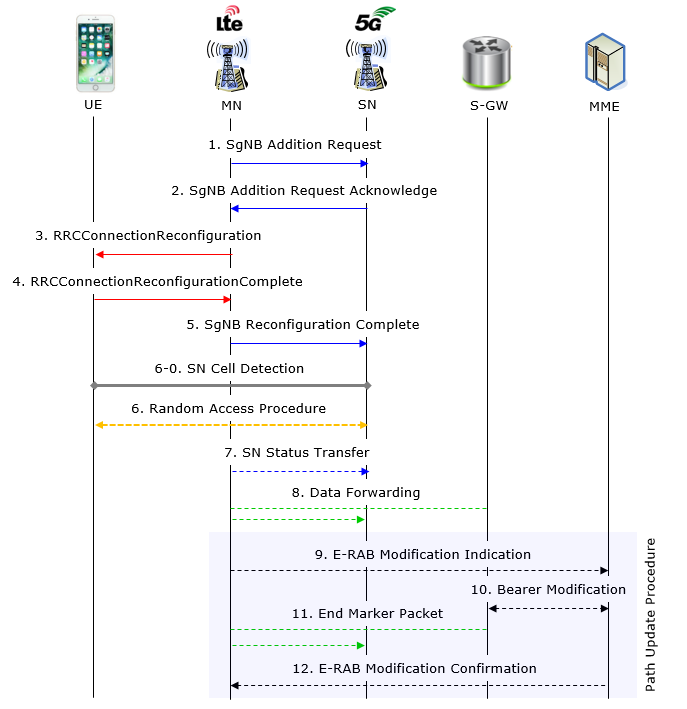|
|
|||||||||||||||||||||||||||||||||||||||||||||||||||||||||||||||||||||||||||||||||||||||||||||||||||||||||||||||||||||||||
|
Interworking with LTE - NSA / ENDC in DetailThis is about one of NR deployment options where LTE work as a master and NR work as a secondary cell (In 3GPP terms, this is about EN-DC (EUTRA-NR Dual Connectivity) / MR-DC with EPC as described in 37.340). In this configuration, UE get connected to LTE network first and then connected to NR via RRC Connection Reconfiguration process. Further details on lower layer process is yet to be studied, but just looking into the conentents of RRCConnectionReconfiguration would give you some general idea about the mechanism.
Overall Network ArchitectureOverall RAN architecture of EN-DC can be illustrated as below (this is based on 37.340 - 4.3.1 and 4.3.2). As you see here, UE is communicating with both LTE eNB and NR gNB in Radio side, but all those communication (signaling and data) are going through LTE core network. Though not shown in this illustration, I would point out that LTE eNB and NR gNB are using their own PHY/MAC (i.e, independent MAC Scheduler)). As you see here, in case of data plane both Master Node(LTE) and Secondary Node(gNB) has direct interface with LTE corenetwork(S-GW), but in case of control plane only Master Node(LTE) has direct interface with LTE core network(MME).
Now let's read the picture. If you take a close look at the illustration and just describe it in words, you would get the descrition as follows. If you don't like reading (like me :), just take 10 minutes (not 10 seconds) and look thorugh each and every part and lines of the picture.
Overall Layer 2 ArchitectureFollowing is based on 37.340 - Figure 4.2.2-3 and Figure 4.2.2-1. As mentioned before, there are roughly two options when LTE and NR interplay. One option is to make LTE as a master and NR as a slave. The other option is to make NR as a master and LTE as a slave. In real deployment, especially at the early deployment, the first option (i.e, LTE Master and NR Slave) would be the major deployment option. This illustration is also to show the overal radio stack structure of LTE Master and NR Slave.
Various types of Bearer for LTE-NR Interworking (EN-DC)In terms of Over The Air(OTA) and Physical Layer perspective, LTE-NR interworking (EN-DC) in NSA(Non-StandAlone) is only one possibility (assuming that LTE always becomes the Anchor), but with the same OTA/Physical layer there can still be multiple possibilities of implementing higher layer bearer. 38.331 - 5.3.1.1 RRC connection control states as follows : In case of EN-DC, the SCG cells use another RAT, namely NR. When configured with EN-DC, user data carried by a DRB may either be transferred via MCG, via NR SCG or via both MCG and NR SCG. Also RRC signalling carried by a SRB may either be transferred via MCG or via both MCG and NR SCG. When DRBs and SRBs are configured with transmission via both MCG and SCG, duplication may be used in both DL and UL. I just tried to turn this statement into illustration as follows (This illustration is based on 37.340 - Figure 4.2.2-3 and Figure 4.2.2-1) : The statement 'DRB may either be transferred via MCG, via NR SCG or via both MCG and NR SCG' can be illustrated as follows.
There is another bearer type called split Bearer (or split DRB). It can be illustrated as follows. You may find more details about this in Split Bearer page.
Types of NR(SCG) addition in EN-DC(LTE+NR Interworking)In ENDC(Eutra NR Dual Connectivity), LTE would become a MCG(Master Cell Group) and NR would become a SCG(Secondary Cell Group). MCG work as the anchor and UE performs initial registration to this anchor cell group, and this anchor cell add one or more Secondary Cells (SCG). In 36.331-5.3.1.1, there are three different types(ways) of adding SCGs to the LTE anchor cell as follows.
Type 1 : Reconfiguration with sync and key change Type 2 : Reconfiguration with sync but without key change Type 3 : Regular NR SCG reconfiguration without Sync / SCG Security Overall Signaling ProcedureThis section is about how to add NR cell(Secondary Node) to an existing LTE Cell.(Master Note). Overall signaling flow is illustrated below. This flow is based on 37.340 - 10.2.1 except the step 6-0 which is added by me. As you may notice,the process is iniated by MN (Master Node : LTE eNB in this case) and final confirmation is done by MME. < 37.340 - Figure 10.2.1-1: Secondary Node Addition procedure >
Following is a summary of overall NSA procedure which would give you more practical sense. This would be the most common NSA protocol sequence that you may see from RRC/NAS log.
LTE RRC ConfigurationThe major role of RRC in LTE-NR Interworking(more specifically ENDC) is to add NR as a secondary cell to LTE Anchor cell. The major IE(information elements) related to this process are
These few IEs has very complicated structures in it and carries so much information. Basically they carries all the information that combines MIB, SIB and RRC Configuration messages in standalone NR. I will take a while to get the detailed understanding on each and every elements of informations in it. Followings are rough summary of informations carried by the RRC Connection Reconfiguration message.
RRCConnectionReconfiguration-v1430-IEs ::= SEQUENCE { sl-V2X-ConfigDedicated-r14 SL-V2X-ConfigDedicated-r14 OPTIONAL, -- Need ON sCellToAddModListExt-v1430 SCellToAddModListExt-v1430 OPTIONAL, -- Need ON perCC-GapIndicationRequest-r14 ENUMERATED{true} OPTIONAL, -- Need ON systemInformationBlockType2Dedicated-r14 OCTET STRING (CONTAINING SystemInformationBlockType2) OPTIONAL, nonCriticalExtension RRCConnectionReconfiguration-v15x0-IEs OPTIONAL }
RRCConnectionReconfiguration-v1510-IEs ::= SEQUENCE { nr-Config-r15 CHOICE { release NULL, setup SEQUENCE { endc-ReleaseAndAdd-r15 BOOLEAN, nr-SecondaryCellGroupConfig-r15 OCTET STRING OPTIONAL, -- Need ON p-MaxEUTRA-r15 P-Max OPTIONAL -- Need ON } } OPTIONAL, -- Need ON sk-Counter-r15 INTEGER (0.. 65535) OPTIONAL, -- Need ON nr-RadioBearerConfig1-r15 OCTET STRING OPTIONAL, -- Need ON nr-RadioBearerConfig2-r15 OCTET STRING OPTIONAL, -- Need ON tdm-PatternConfig-r15 CHOICE { release NULL, setup SEQUENCE { subframeAssignment-r15 SubframeAssignment-r15, harq-Offset-r15 INTEGER (0.. 9) } } OPTIONAL, -- Need ON nonCriticalExtension SEQUENCE {} OPTIONAL }
RRCConnectionReconfiguration-v15x0-IEs ::= SEQUENCE { endc-Config-r15 SEQUENCE { scg-ConfigReleaseNR-r15 BOOLEAN, sk-Counter-r15 INTEGER (0.. 65535) OPTIONAL, -- Need ON nr-SecondaryCellGroupConfig-r15 OCTET STRING OPTIONAL, -- Need ON nr-RadioBearerConfig-r15 OCTET STRING OPTIONAL, -- Need ON nr-RadioBearerConfigS-r15 OCTET STRING OPTIONAL, -- Need ON tdm-PatternSingle-Tx-r15 SEQUENCE { subframeAssignment-r15 SubframeAssignment-r15, harq-Offset-r15 INTEGER (0.. 9) OPTIONAL -- Need ON } OPTIONAL -- Need ON } OPTIONAL -- Need ON nonCriticalExtension SEQUENCE {} OPTIONAL }
nr-SecondaryCellGroupConfig1-r15,nr-SecondaryCellGroupConfig2-r15 : Includes NR RRCReconfiguration message. The field includes the configuration of RBs configured with NR PDCP. nr-RadioBearerConfig : Include NR RadioBearerConfig. Mainly for DRB, EPS, NR PDCP Configuration
RRCConnectionResume-v15x0-IEs ::= SEQUENCE { sk-Counter-r15 INTEGER (0.. 65535) OPTIONAL, -- Need ON nr-RadioBearerConfig-r15 OCTET STRING OPTIONAL, -- Need ON nr-RadioBearerConfigS-r15 OCTET STRING OPTIONAL, -- Need ON nonCriticalExtension SEQUENCE {} OPTIONAL } Example >As mentioned above, RRC Connection Reconfiguration in LTE for Adding NR Cell carries only a couple of container that carries a huge tree of NR RRC message. Due to the complicated RRC structure in NR, I found it difficult to put the whole structure and description of any NR RRC message in a single page. In this example, you will see a couple of starting points of NR RRC part as shown below and you should follow the link until you reach the final destination. NOTE : If you want to see the contents of full log with Amarisoft Log viewer, go to LogAnalysis section and click on 'Sample Log' in this tutorial of Amarisoft TechAcademy. rrcConnectionReconfiguration measConfig mobilityControlInfo dedicatedInfoNASList radioResourceConfigDedicated nonCriticalExtension laterNonCriticalExtension nonCriticalExtension otherConfig-r9 fullConfig-r9 nonCriticalExtension sCellToReleaseList-r10 sCellToAddModList-r10 nonCriticalExtension systemInformationBlockType1Dedicated-r11 nonCriticalExtension wlan-OffloadInfo-r12 scg-Configuration-r12 sl-SyncTxConfrol-r12 sl-DiscConfig-r12 sl-CommonConfig-r12 nonCriticalExtension sCellToReleaseListExt-r13 sCellToAddModListExt-r13 lwa-Configuration-r13 lwip-Configuration-r13 rdwi-Configuration-r13 nonCriticalExtension sl-V2X-ConfigDedicated-r14 sCellToAddModListExt-v1430 perCC-GapIndicationRequest-r14 systemInformationBlockType2Dedicated-r14 nonCriticalExtension nr-Config-r15 endc-ReleaseAndAdd-r15 nr_SecondaryCellGroupConfig-r15 cellGroupID rlc-BearerToAddModList mac-CellGroupConfig physicalCellGroupConfig servCellIndeix physCellId setup commonControlResources commonSearchSpaces searchSpaceSIB1 searchSpaceOtherSystemInformation pagingSearchSpace ra_ConfrolResourceSet ra_SearchSpace setup supplementaryUplinkConfig supplementaryUplinkConfig ssb_PositionsInBurst ssb_periodicityServingCell dmrs_TypeA_Position lte_CRS_ToMatchAround rateMatchPatternToAddModList rateMatchPatternToReleaseList subcarrierSpacing referenceSubcarrierSpacing dl_UL_TransmissionPeriodicity nrofDownlinkSlots nrofDownlinkSymbols nrofUplinkSlots nrofUplinkSymbols tdd_UL_DL_ConfigurationCommon2 ss_PBCH_BlockPower newUE_Identity t304 rach_ConfigDedicated rlf-TimersAndConstants rlmInSyncOutOfSyncThreshold tdd_UL_DL_ConfigurationDedicated initialDownlinkBWP sps_Config radioLinkMonitoringConfig downlinkBWP_ToReleaseList downlinkBWP_ToAddModList firstActiveDownlinkBWP_Id bwp_InactivityTimer defaultDownlinkBWP_Id initialUplinkBWP uplinkBWP_ToReleaseList uplinkBWP_ToAddModList firstActiveUplinkBWP_Id pusch_ServingCellConfig supplementaryUplink pdsch_ServingCellConfig csi_MeasConfig carrierSwitching sCellDeactivationTimer crossCarrierScheduleConfig tag_Id ue_BeamLockFunction pathlossReferenceLinking p_MaxEUTRA-r15 sk-Counter-r15 nr-RadioBearerConfig2-r15 tdm-PatternConfig-r15 nonCriticalExtension Measurement (LTE-NR Measurement)In real operation, it is expected for LTE to perform the measurement of the NR cell before it tries adding it. When it comes to measurement, first we need to think of what kind of measurement event to be used. And since this is interfrequency/interRAT from the point of LTE we need to think of measurement gap. In terms of measurement event, we are using the existing event B1 and B2 and not new event is defined for NR measurement(see here for the details), but in terms of measurement gap, we got a lot of new gap patterns for NR measurement(see here for the details). NOTE : If you want to see the contents of full log with Amarisoft Log viewer, go to LogAnalysis section and click on 'Sample Log' in this tutorial of Amarisoft TechAcademy. Example 01 >Following example message is from Amari Callbox and a commercial UE. I am just putting the measurement related part here and refer to this file for the full contents of the message. message c1: rrcConnectionReconfiguration: { rrc-TransactionIdentifier 0, criticalExtensions c1: rrcConnectionReconfiguration-r8: { measConfig { measObjectToAddModList { { measObjectId 1, measObject measObjectEUTRA: { carrierFreq 300, allowedMeasBandwidth mbw100, presenceAntennaPort1 TRUE, neighCellConfig '01'B } }, { measObjectId 2, measObject measObjectNR-r15: { carrierFreq-r15 632256, rs-ConfigSSB-r15 { measTimingConfig-r15 { periodicityAndOffset-r15 sf20-r15: 0, ssb-Duration-r15 sf1 }, subcarrierSpacingSSB-r15 kHz30 }, quantityConfigSet-r15 1, bandNR-r15 setup: 78 } } }, reportConfigToAddModList { { reportConfigId 1, reportConfig reportConfigInterRAT: { triggerType event: { eventId eventB1-NR-r15: { b1-ThresholdNR-r15 nr-RSRP-r15: 56, reportOnLeave-r15 FALSE }, hysteresis 0, timeToTrigger ms100 }, maxReportCells 8, reportInterval ms120, reportAmount r1, reportQuantityCellNR-r15 { ss-rsrp TRUE, ss-rsrq TRUE, ss-sinr TRUE } } } }, measIdToAddModList { { measId 1, measObjectId 2, reportConfigId 1 } }, quantityConfig { quantityConfigEUTRA { filterCoefficientRSRP fc3 }, quantityConfigNRList-r15 { { measQuantityCellNR-r15 { filterCoeff-RSRP-r15 fc3 } } } }, measGapConfig setup: { gapOffset gp0: 16 } }, ...... }
message c1: measurementReport: { criticalExtensions c1: measurementReport-r8: { measResults { measId 1, measResultPCell { rsrpResult 69, rsrqResult 30 }, measResultNeighCells measResultNeighCellListNR-r15: { { pci-r15 500, measResultCell-r15 { rsrpResult-r15 79, rsrqResult-r15 65, rs-sinr-Result-r15 89 } } } } } } } SCG FailureVarious type of failure can happen during NR addition after UE recieves RRC Connection Reconfiguration. When this happens, UE send SCG Failure Information message with various failure cause as listed below. This is based on 38.331 5.7.3.3. You should see 38.331 v15.4 or higher)
NOTE : If you speak / understand Korean, you may refer to this YouTube by Sean Mobile Channel(@22:00) Carrier Aggregation Setup in NRAfter you add NR cell to LTE Anchor completing ENDC, you can add other NR cells to establish Carrer Aggregation(CA). The addition of secondary NR cells can be done at the same step as ENDC establishment or done separately after the ENDC Setup. This NR CA process is very similar to LTE CA establishment process. Overall procedure is as shown below.
Reference[1] LTE-NR tight-interworking and the first steps to 5G (Errisson Research Blog) [2] 4G-5G Interworking (SamSung)
|
|||||||||||||||||||||||||||||||||||||||||||||||||||||||||||||||||||||||||||||||||||||||||||||||||||||||||||||||||||||||||




